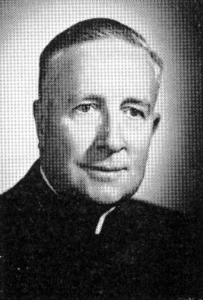In 1841, Fordham University in New York was re-founded; it had earlier been the diocesan college of St. John the Baptist. Its first president was Father John McCloskey [Ed’s note: not the one who writes here at TCT]. In 1875, he became the first American-born cardinal.
The ordinary at the time, Bishop John Hughes, figured that “his college would soon outdistance Georgetown and would always be the most important Catholic institution in the country – because, after all, he had not the pleasure of founding the others.” Whether this prediction has come about can be disputed. But the wit of its concluding words cannot.
Those lines were spoken in 1941 by Father Robert I. Gannon, S.J., at the 100th anniversary of the re-founding of Fordham, a few months before Pearl Harbor. (His address is found in Gannon’s After Black Coffee. St. John’s College was renamed Fordham University in 1907).
At this 1941 convocation, some thousand presidents, deans, professors, and guests gathered. All were decked in colorful academic robes. Gannon, who had studied at Cambridge in England, recalled his tutor having been present “at the American premier of caps and gowns at the opening (in 1876) of the Johns Hopkins University.” Gannon was not enthusiastic over the “German influence on our learning institutions.” He was not a fan of practical or specialized education, however much he coped with it as president of Fordham (1936-1949).
Imagine, Gannon reflected, that an earlier Fordham graduates, say, Bishop (Sylvester Horton) Rosecrans (1827-1878, first bishop of Columbus, Ohio), examined “the mental content of a modern college student (circa 1941) who had majored, let us say, in traffic problems or in hotel management; he might, in his simplicity, mistake an arts man for an apprentice.” One has to know Greek philosophy and medieval guilds to catch the import of this episcopal “simplicity.”
Education consisted more in “glancing backward” than forward. Gannon added: “To us simpler folk, this wistful glancing backward is a heartening sign. It means that more people than we realize are still aware that education, especially higher education, has a twofold function; that its aim is not only to increase knowledge, but to preserve it.”

We do not preserve things unless we think it important to do so. We do not seek new knowledge unless we think that something is still to be discovered. We do not do either unless we can think – period, which, I take it, was, or once was, the main purpose of higher education.
Gannon stated his view succinctly: “We are fond of boasting that there has been more progress in the fifty years just passed than in the previous five hundred. But progress toward what?”
The motto of Fordham is Sapientia et Doctrina, which Gannon translated as “wisdom and information.” He compared this motto with the Veritas of Harvard and the Hebrew Urim v’Thummim of Yale (in Latin, Lux et Veritas). Each Harvard or Yale word is “all-embracing.” But the Fordham motto stressed wisdom before information.
In days before all factual arguments could seemingly be found in Google, Gannon already wondered: “How much information is it wise for one generation to know?” He was not, I think, advocating the virtues of ignorance but the need for reflective order.
Few people know the technical definition of wisdom: “knowledge of conclusions through first causes.” Still a few wise men are found. They say: “I believe that character, not wealth or power or position, is of supreme worth. I believe that love is the greatest thing in the world.”
Much current political rhetoric is precisely about how “wealth, power, and position” dominate our public life, rather than character and a love that is unselfish.
In 1941, recalling the Great War while seeing Europe already in flames, Gannon observed: “We all know that poor old Europe was sick unto death long before she decided to end it all with an overdose of modernity.” With the European Union’s anti-Christian bias and its rapid population decline, Gannon’s words are more appropriate seventy-five years after he spoke them on the Rose Hill Campus.
The Fordham president did not despair. The grounds of his hope were the liberal arts and something he called “Christian humanism.” He was naturally concerned with ultimate things, with “meriting for ourselves an incorruptible crown which shall be ours for Eternity.”
He called himself a “conservative,” a realist for sure. “Wisdom subjects,” he knew, no longer dominated any university: “Theology went overboard many years ago. Philosophy flourishes in outline form as a species of cultural history. Metaphysics has become a Roman Catholic aberration. Literature . . . has become in practice more and more the science – or the bones – of literature,” a bleak future.
“Soon we shall have the universe completely tabulated, and no one will know what it means.” The tabulation is ever more complete; what it means ever less clear. Sapientia and Doctrina seem opposed to each other. Yet universities, including Harvard, Yale, and Fordham, were founded on the premise that they belong together.














